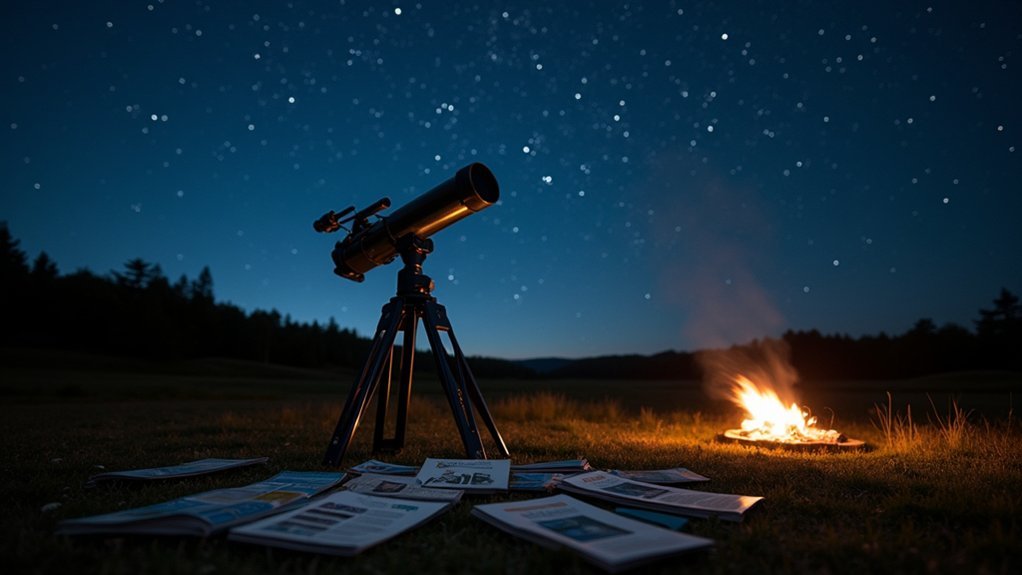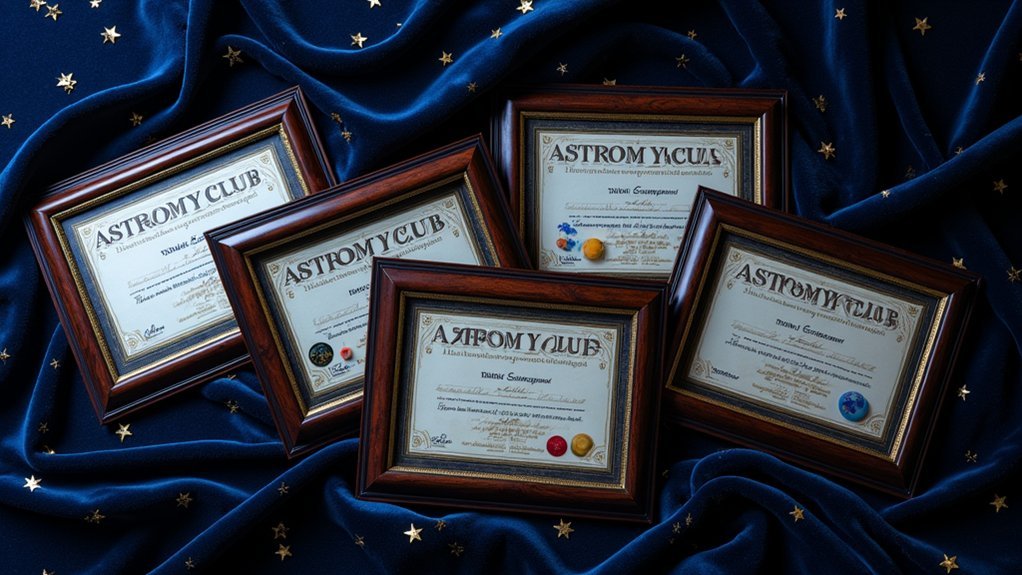Lunar maria appear most vivid during a full moon because direct overhead lighting eliminates shadows and maximizes the albedo contrast between dark basaltic plains and bright highlands. You’ll easily spot these ancient volcanic features as dark patches that cover about 16% of the lunar surface. With binoculars or a small telescope, you can identify major maria like Oceanus Procellarum and Mare Tranquillitatis. The stark contrasts during full moon reveal the Moon’s fascinating volcanic history.
Understanding The Nature of Lunar Maria

While gazing at the full Moon, you’ll immediately notice the dark patches that contrast with the brighter surrounding terrain. These are lunar maria, vast basaltic plains covering about 16% of the Moon’s surface, with most concentrated on the Earth-facing side.
Formed through ancient volcanic activity, these features consist of iron-rich mare basalts that erupted primarily between 3 and 3.5 billion years ago, with the youngest flows dating back 1.2 billion years.
The basaltic lavas contain remarkably high titanium concentrations—up to 15% by weight, far exceeding Earth’s basalts.
During a full Moon, these dark plains become particularly prominent as direct sunlight illuminates their surface, maximizing the contrast with the lighter highlands and revealing the Moon’s fascinating volcanic history.
Full Moon Illumination and Maria Visibility
When you observe the moon at its fullest, you’ll notice the maria stand out dramatically due to direct overhead lighting that eliminates shadows and creates a shadow-free lunar landscape.
This illumination pattern maximizes the albedo contrast between the dark basaltic maria and the lighter highland regions, making their boundaries appear more defined.
You can easily distinguish features like Mare Imbrium without optical aids during full moon phases, as the enhanced contrast highlights the maria’s extensive volcanic plains against the brighter surrounding terrain.
Direct Overhead Lighting
How dramatically the appearance of lunar maria changes during a full moon! When sunlight strikes the lunar surface at a perfect 90-degree angle, you’ll notice the dark basaltic plains of the maria standing out in stark contrast against the brighter highlands.
This direct overhead lighting minimizes shadows while maximizing visibility of the maria’s circular basins and surrounding features.
You’ll find that full moon conditions reduce the impact of atmospheric interference, providing exceptional clarity for observing these ancient lava plains. The illumination enhances the natural contrast between the darker maria and lighter highlands, making identification much easier with the naked eye.
As an amateur astronomer, you’ll appreciate how this ideal lighting reveals detailed features without specialized equipment, showcasing the moon’s geological history in remarkable clarity.
Shadow-Free Surface Features
What better opportunity to observe lunar maria than during a full moon‘s shadow-free illumination?
With direct sunlight bathing the moon’s entire Earth-facing side, you’ll see minimal shadows that enhance the visibility of dark basaltic plains against lighter highlands.
The full moon’s bright disc reveals subtle color variations among different maria, allowing you to appreciate their distinct chemical compositions and ages.
Without the interference of shadows, you can easily identify prominent impact basins like Mare Imbrium and distinctive wrinkle ridges that characterize these ancient lava plains.
The absence of shadow-induced contrast effects makes it simpler to spot Oceanus Procellarum and other major surface features.
You’ll notice how these vast, dark regions stand out dramatically during full moon phases, offering the clearest view of lunar maria’s true appearance.
Albedo Contrast Enhancement
The striking contrast between dark maria and bright highlands reaches its peak during a full moon, transforming the lunar landscape into a clearly defined map of ancient volcanic activity.
When fully illuminated by the sun, the moon’s surface features display maximum albedo differences that make the darker maria stand out dramatically against the lighter terrain.
You’ll notice the circular outlines of these ancient basaltic plains become unmistakable during full moon phases, covering about 16% of the lunar surface.
The enhanced illumination eliminates shadows that might otherwise obscure these features, allowing you to clearly distinguish their surface textures and boundaries.
This ideal lighting creates a stark color contrast that reveals the maria’s true nature—vast plains of solidified lava floods that occurred billions of years ago.
Contrast Between Dark Maria and Bright Highlands
When you observe a full moon, you’ll immediately notice the striking contrast between the dark maria and the bright highlands, an effect that dramatically enhances the moon’s visible features.
This contrast isn’t just visually appealing but reveals fundamental geological differences—the darker maria consisting of iron-rich basaltic plains while the brighter highlands contain more reflective materials.
You’re seeing this stark black-and-white patterning at its most dramatic during full moon phases when direct sunlight maximizes the reflectivity differences between these distinct lunar terrains.
Contrast Enhancement Effect
Most striking during a full moon is the dramatic contrast between the lunar maria and highlands, creating a celestial spectacle you can observe with even modest equipment. The full moon’s direct sunlight hits the lunar surface nearly vertically, maximizing the visibility of this remarkable contrast.
When you’re viewing the full moon, you’ll notice the maria—covering about 16% of the lunar surface—appear distinctly darker against the brighter highlands. This effect is particularly pronounced in regions like Mare Imbrium and Oceanus Procellarum, where the stark difference in albedo makes identification easy.
The iron-rich basaltic composition of the maria absorbs more light than the surrounding highlands, enhancing this contrast effect.
You’ll appreciate intricate details and textures during this phase that aren’t as visible during crescent or gibbous phases.
Geological Feature Distinctions
Examining the lunar surface during a full moon reveals remarkable geological contrasts that tell the story of our celestial neighbor’s volcanic history.
As you gaze upward, you’ll notice the stark difference between dark lunar maria and bright highlands—a reflection of the Moon’s complex past.
- The dark basaltic plains of maria occupy about 16% of the lunar surface, primarily on the Earth-facing side.
- Maria formed through ancient volcanic activity, creating iron-rich surfaces that absorb more sunlight.
- Highlands consist primarily of anorthosite, a lighter rock that reflects more sunlight.
- Chemical composition creates distinctive coloration—maria contain higher concentrations of titanium and iron, while highlands are rich in plagioclase.
This composition difference explains why the maria appear as dark patches against the brighter highland backdrop during a full moon.
Equipment Recommendations for Maria Observation

Three essential tools can greatly enhance your lunar maria observations during a full moon. First, invest in quality binoculars with at least 10x magnification to distinguish the darker basaltic plains from the lighter highlands.
While binoculars provide a good starting point, a telescope with a 4-inch or larger aperture will reveal considerably more detail, including wrinkle ridges and impact craters within the maria.
A lunar filter is your third essential tool, reducing the glare that often accompanies full moon observation while improving contrast between different surface features.
Before your viewing session, familiarize yourself with prominent maria like Mare Imbrium and Oceanus Procellarum. This preparation provides valuable context to your observation, helping you identify specific features when the full moon’s lighting maximizes the contrast of these fascinating lunar landscapes.
The Historical Significance of Maria Mapping
While today’s astronomers understand lunar maria as ancient volcanic plains, their mysterious dark appearance prompted early stargazers to mistake them for actual seas on the Moon’s surface. This misunderstanding led to a fascinating legacy of nautical nomenclature that persists in modern lunar science.
- The mapping of maria began with Galileo’s observations and evolved dramatically through the Apollo missions, revealing vast lava plains rather than water bodies.
- Oceanus Procellarum, the largest maria, showcases evidence of young lunar volcanism that reshaped our understanding of the Moon’s geological timeline.
- Early maps mistakenly attributed maria formation to water, but modern science revealed they’re massive impact crater basins filled with solidified lava.
- The evolution from mythological interpretation to scientific mapping represents humanity’s journey from superstition to understanding lunar geology.
Prominent Maria Features to Identify During Full Moon

The full moon offers amateur astronomers a perfect opportunity to identify the Moon’s most distinctive maria features. During this phase, the dark regions of the lunar maria create striking contrasts against the brighter highlands.
Oceanus Procellarum, the largest of these basaltic plains, becomes easily distinguishable along the western edge of the visible lunar surface.
Spanning over 2,500 kilometers, Oceanus Procellarum dominates the Moon’s western hemisphere with its dark, expansive basaltic plain.
You’ll immediately notice Copernicus crater standing out with its bright appearance and radiating rays amid the surrounding dark maria. Mare Tranquillitatis (Sea of Tranquility) appears as a prominent dark patch on the eastern side.
These maria formed billions of years ago from massive volcanic eruptions that flooded lower-lying areas with basaltic lava.
With binoculars or a small telescope, you can observe the varying textures and subtle color differences between different maria regions, revealing their complex volcanic histories.
Frequently Asked Questions
What Does Maria Represent on the Moon?
Maria represent the Moon’s dark plains formed by ancient volcanic eruptions. You’re seeing solidified lava flows that early astronomers mistakenly thought were seas—that’s why they’re named “maria,” the Latin word for “seas.”
What Do the Mares on the Moon Represent?
Mares on the Moon represent vast basaltic lava plains that solidified billions of years ago. You’ll notice they’re the dark patches you see on the lunar surface, once mistakenly thought to be actual seas.
Why Are the Lunar Maria Concentrated Almost Entirely on the Near Side of the Moon?
Lunar maria concentrate on the near side because you’ll find a thinner crust there, allowing lava to reach the surface easily. The far side’s thicker crust blocked volcanic eruptions that would’ve formed these dark basaltic plains.
What Is the Maria on the Moon Can Be Best Described As?
You’ll recognize lunar maria as vast, smooth basaltic plains formed by ancient lava flows. They’re the dark patches you see on the Moon, once mistakenly thought to be seas, covering 16% of the lunar surface.
In Summary
You’ll find lunar maria most striking during a full moon because complete illumination maximizes the contrast between the dark basaltic plains and lighter highlands. They’re easiest to spot without shadows obscuring details. Next full moon, grab your binoculars or telescope and identify major features like Mare Imbrium and Oceanus Procellarum. You’re witnessing what early astronomers mapped centuries ago—the moon’s most distinctive geological features.





Leave a Reply